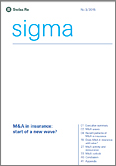Swiss Re: M&A in insurance: start of a new wave?
May 21 2015
Mergers and acquisitions (M&A) tend to come in waves. After declining sharply in the wake of the financial crisis, overall M&A activity in the insurance sector has been relatively low in recent years and has only just started to increase. Surveys also suggest sentiment towards M&A is turning as insurers look for ways to deploy excess capital, boost or diversify revenue growth, build scale and ultimately bolster profitability in the face of ongoing economic headwinds.
Swiss Re
-
SIRC: Distinct reinsurance solutions are emerging to address emerging capital strategies: Guy Carpenter
- November 4
As insurers improve their understanding of the risks they are carrying and capital productivity, structured reinsurance and alternative sources of reinsurance capital are being increasingly considered, Guy Carpenter’s Justin Ward says.
-
QBE’s Hammond on transformation and growth
- July 2
The Asia chief executive discusses Covid-19, going digital and restructuring.
-
Swiss Re: Nat cats and man-made disasters in 2018
- April 10
Climate change, increased urbanisation and a growing concentration of assets were on the risk agenda for 2018.
-
Willis Towers Watson: 2019 Asia Market Report
- March 19
Economic uncertainty, more complex risks and tighter underwriting are all influencing Asia's markets.
-
QBE | Elevating customer experience, humanising claims: QBE Asia’s ‘Solutions in a Box’
Vastly improving turnaround times and personalising service delivery, QBE Asia’s award-winning, end-to-end bundled claims solutions is a game-changer for the insurance industry.
-
Beazley | What does cyber protection look like from day 1 to day 600 and beyond?
Cybersecurity is no longer just an IT concern, but a governance issue that belongs on the boardroom agenda.
-
Sedgwick | Preparing for the next storm
Insurance industry needs to recalibrate, invest in innovation and strengthen systems, talent and data practices.
-
Peak Re | From climate modelling to market opportunity: Forging a new clarity on Southeast Asia’s climate risk
Southeast Asia's protection gap: a crisis of clarity, not just capital

